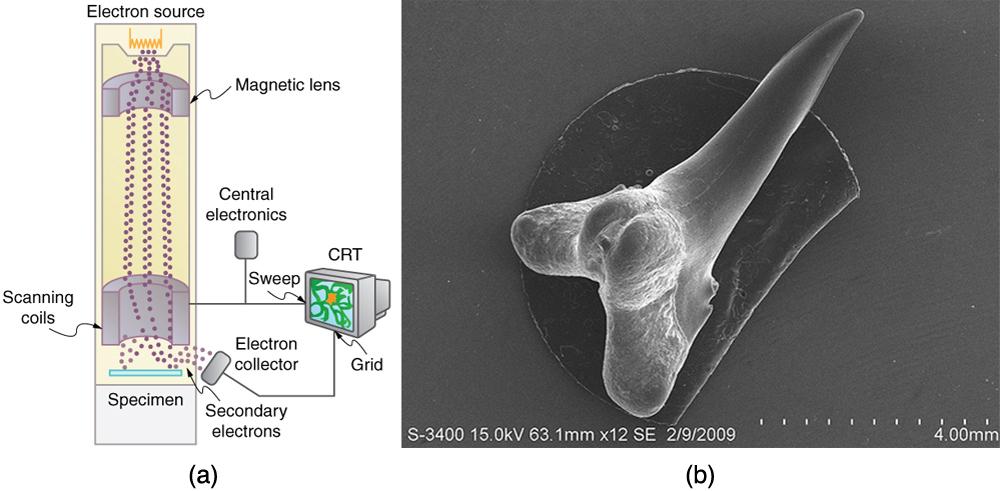De Broglie Wavelength
In 1923, a French physics graduate student named Prince Louis-Victor de Broglie (1892–1987) made a radical proposal based on the hope that nature is symmetric. If EM radiation has both particle and wave properties, then nature would be symmetric if matter also had both particle and wave properties. If what we once thought of as an unequivocal wave, or EM radiation, is also a particle, then what we think of as an unequivocal particle, or matter, may also be a wave. De Broglie’s suggestion, made as part of his doctoral thesis, was so radical that it was greeted with some skepticism. A copy of his thesis was sent to Einstein, who said it was not only probably correct, but that it might be of fundamental importance. With the support of Einstein and a few other prominent physicists, de Broglie was awarded his doctorate.
De Broglie took both relativity and quantum mechanics into account to develop the proposal that all particles have a wavelength, given by
12.34 where is Planck’s constant and is momentum. This is called the de Broglie wavelength. (Note that we already have this for photons from the equation .) The hallmark of a wave is interference. If matter is a wave, then it must exhibit constructive and destructive interference. Why isn’t this ordinarily observed? The answer is that in order to see significant interference effects, a wave must interact with an object about the same size as its wavelength. Since is very small, is also small, especially for macroscopic objects. A 3-kg bowling ball moving at 10 m/s, for example, has
12.35 This means that to see its wave characteristics, the bowling ball would have to interact with something about in size—far smaller than anything known. When waves interact with objects much larger than their wavelength, they show negligible interference effects and move in straight lines, such as light rays in geometric optics. To get easily observed interference effects from particles of matter, the longest wavelength and, hence, the smallest mass possible would be useful. Therefore, this effect was first observed with electrons.
American physicists, Clinton J. Davisson and Lester H. Germer, in 1925 and, independently, British physicist, G. P. Thomson (son of J. J. Thomson, discoverer of the electron), in 1926 scattered electrons from crystals and found diffraction patterns. These patterns are exactly consistent with interference of electrons having the de Broglie wavelength and are somewhat analogous to light interacting with a diffraction grating. (See Figure 12.20.)
Connections: Waves
All microscopic particles, whether massless, like photons, or having mass, like electrons, have wave properties. The relationship between momentum and wavelength is fundamental for all particles.
De Broglie’s proposal of a wave nature for all particles initiated a remarkably productive era in which the foundations for quantum mechanics were laid. In 1926, the Austrian physicist, Erwin Schrödinger (1887–1961), published four papers in which the wave nature of particles was treated explicitly with wave equations. At the same time, many others began important work. Among them was German physicist, Werner Heisenberg (1901–1976), who, like many other contributions to quantum mechanics, formulated a mathematical treatment of the wave nature of matter that used matrices rather than wave equations. We will deal with some specifics in later sections, but it is worth noting that de Broglie’s work was a watershed for the development of quantum mechanics. De Broglie was awarded the Nobel Prize in 1929 for his vision, as were Davisson and G. P. Thomson in 1937 for their experimental verification of de Broglie’s hypothesis.
Example 12.7 Electron Wavelength versus Velocity and Energy
For an electron having a de Broglie wavelength of 0.167 nm—appropriate for interacting with crystal lattice structures that are about this size: (a) Calculate the electron’s velocity, assuming it is nonrelativistic. (b) Calculate the electron’s kinetic energy in eV.
Strategy
For part (a), since the de Broglie wavelength is given, the electron’s velocity can be obtained from by using the nonrelativistic formula for momentum, For part (b), once is obtained (and it has been verified that is nonrelativistic), the classical kinetic energy is simply
Solution for (a)
Substituting the nonrelativistic formula for momentum () into the de Broglie wavelength gives
12.36 Solving for gives
12.37 Substituting known values yields
12.38 Solution for (b)
While fast compared with a car, this electron’s speed is not highly relativistic, so we can comfortably use the classical formula to find the electron’s kinetic energy and convert it to eV as requested.
12.39
Discussion
This low energy means that these 0.167-nm electrons could be obtained by accelerating them through a 54.0-V electrostatic potential; an easy task. The results also confirm the assumption that the electrons are nonrelativistic, since their velocity is just more than 1 percent of the speed of light and the kinetic energy is about 0.01 percent of the rest energy of an electron, the latter of which is equal to 0.511 MeV. If the electrons had turned out to be relativistic, we would have had to use more involved calculations employing relativistic formulas.



